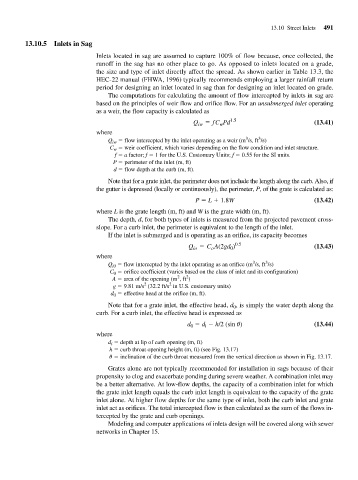Page 533 - Fair, Geyer, and Okun's Water and wastewater engineering : water supply and wastewater removal
P. 533
JWCL344_ch13_457-499.qxd 8/17/10 4:32 PM Page 491
13.10 Street Inlets 491
13.10.5 Inlets in Sag
Inlets located in sag are assumed to capture 100% of flow because, once collected, the
runoff in the sag has no other place to go. As opposed to inlets located on a grade,
the size and type of inlet directly affect the spread. As shown earlier in Table 13.3, the
HEC-22 manual (FHWA, 1996) typically recommends employing a larger rainfall return
period for designing an inlet located in sag than for designing an inlet located on grade.
The computations for calculating the amount of flow intercepted by inlets in sag are
based on the principles of weir flow and orifice flow. For an unsubmerged inlet operating
as a weir, the flow capacity is calculated as
Q iw = f C Pd 1.5 (13.41)
w
where
3
3
Q iw flow intercepted by the inlet operating as a weir (m /s, ft /s)
C w weir coefficient, which varies depending on the flow condition and inlet structure.
f a factor; f 1 for the U.S. Customary Units; f 0.55 for the SI units.
P perimeter of the inlet (m, ft)
d flow depth at the curb (m, ft).
Note that for a grate inlet, the perimeter does not include the length along the curb. Also, if
the gutter is depressed (locally or continuously), the perimeter, P, of the grate is calculated as:
P L 1.8W (13.42)
where L is the grate length (m, ft) and W is the grate width (m, ft).
The depth, d, for both types of inlets is measured from the projected pavement cross-
slope. For a curb inlet, the perimeter is equivalent to the length of the inlet.
If the inlet is submerged and is operating as an orifice, its capacity becomes
Q io = C A(2gd ) 0.5 (13.43)
0
o
where
3
3
Q i0 flow intercepted by the inlet operating as an orifice (m /s, ft /s)
C 0 orifice coefficient (varies based on the class of inlet and its configuration)
2
2
A area of the opening (m , ft )
2
2
g 9.81 m/s (32.2 ft/s in U.S. customary units)
d 0 effective head at the orifice (m, ft).
Note that for a grate inlet, the effective head, d 0 , is simply the water depth along the
curb. For a curb inlet, the effective head is expressed as
d 0 d i h/2 (sin ) u (13.44)
where
d i depth at lip of curb opening (m, ft)
h curb throat opening height (m, ft) (see Fig. 13.17)
u inclination of the curb throat measured from the vertical direction as shown in Fig. 13.17.
Grates alone are not typically recommended for installation in sags because of their
propensity to clog and exacerbate ponding during severe weather. A combination inlet may
be a better alternative. At low-flow depths, the capacity of a combination inlet for which
the grate inlet length equals the curb inlet length is equivalent to the capacity of the grate
inlet alone. At higher flow depths for the same type of inlet, both the curb inlet and grate
inlet act as orifices. The total intercepted flow is then calculated as the sum of the flows in-
tercepted by the grate and curb openings.
Modeling and computer applications of inlets design will be covered along with sewer
networks in Chapter 15.

